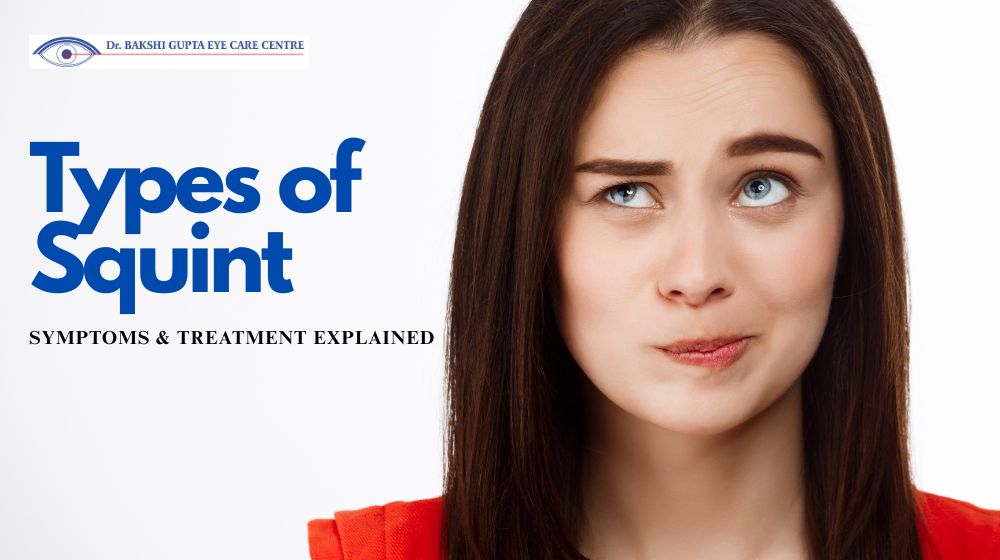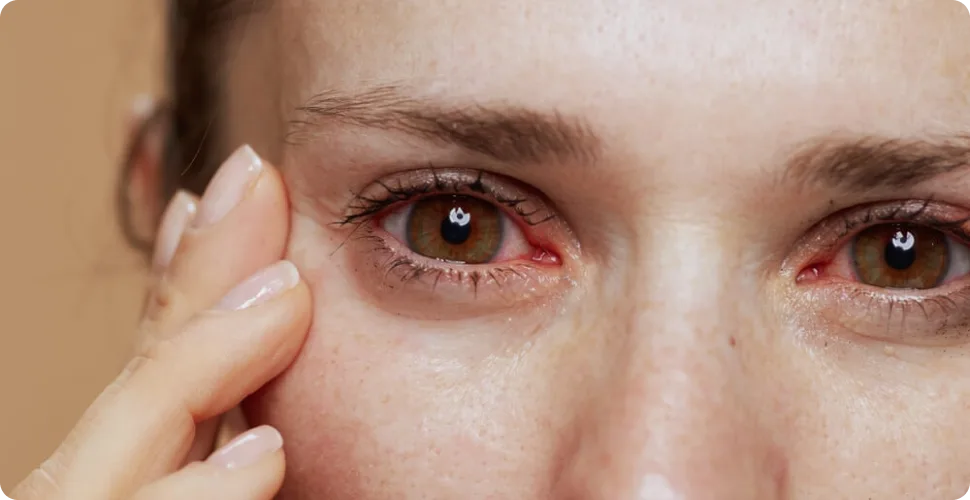Squint, also known as strabismus, is an eye condition where both eyes do not align properly when focusing on an object. While one eye looks straight ahead, the other may turn inward, outward, upward, or downward. This misalignment can be constant or intermittent, and it often affects vision, depth perception, and confidence if left untreated. Understanding the types of squint is essential for early detection, proper treatment, and preventing long-term complications such as lazy eye (amblyopia).
In this blog, we’ll explore the different types of squint, their unique characteristics, causes, and treatment options, including commonly known conditions like esotropia squint, exotropia squint, and the less common V pattern esotropia.
What is Squint?
Squint occurs when the eye muscles fail to work together in a coordinated manner. Normally, both eyes move in sync, sending aligned images to the brain. In squint, however, the misalignment disrupts this coordination, leading to double vision or the brain ignoring signals from one eye. This can affect both children and adults, though early intervention is more effective in preventing complications.
The Different Types of Squint
There are several different types of squint, and they are generally categorized based on the direction of eye misalignment:
- Esotropia (Inward-turning squint)
- Exotropia (Outward-turning squint)
- Hypertropia (Upward-turning squint)
- Hypotropia (Downward-turning squint)
- Pattern strabismus (such as V pattern esotropia)
Let’s look at these in more detail, focusing on the more common and medically significant types.
1. Esotropia Squint
Esotropia squint is a condition where one or both eyes turn inward toward the nose. It is one of the most common forms of squint in children and can be either constant or intermittent.
Types of Esotropia
- Infantile Esotropia: Appears in babies within the first 6 months of life. It usually requires surgical correction.
- Accommodative Esotropia: Caused by uncorrected farsightedness (hyperopia). Children may squint when trying to focus, and glasses often help correct it.
- Non-accommodative Esotropia: Not related to vision correction and may need surgery.
Symptoms
- Crossed eyes
- Double vision (in older children/adults)
- Tilting of the head to compensate
Treatment Options
- Glasses (for accommodative type)
- Eye patching for amblyopia
- Surgery to correct muscle alignment
- Vision therapy in some cases
2. Exotropia Squint
Exotropia squint occurs when one or both eyes turn outward, away from the nose. It is less common than esotropia but can appear in both children and adults.
Types of Exotropia
- Intermittent Exotropia: The most common type, where the outward turn happens occasionally, especially when tired or distracted.
- Constant Exotropia: More severe, where the outward turning is persistent.
Symptoms
- Outward drifting of one eye
- Closing one eye in bright sunlight
- Headaches or eye strain
- Difficulty focusing on near objects
Treatment Options
- Glasses with prism correction
- Vision therapy exercises
- Surgery for persistent or severe cases
3. Exotropia in Infants
One important subset is exotropia in infants. While occasional outward eye turning in newborns is normal, persistent exotropia beyond 4–6 months of age requires medical evaluation.
Causes
- Neurological conditions
- Family history of squint
- Premature birth or low birth weight
Why Early Diagnosis Matters
Early treatment is vital because untreated exotropia in infants can lead to amblyopia (lazy eye) and impaired binocular vision. Pediatric ophthalmologists often recommend close monitoring, corrective glasses, or surgery depending on the severity.
4. Squint Eye Exotropia
The term squint eye exotropia is often used by patients to describe the outward turning of the eye. This condition not only affects vision but also impacts appearance, making early treatment important for both visual health and self-confidence.
In adults, squint eye exotropia may develop due to:
- Nerve palsy
- Trauma
- Untreated childhood strabismus
- Neurological diseases
Corrective options for adults include surgery, prism lenses, and vision therapy to restore alignment and function.
5. Hypertropia (Upward-turning squint)
Hypertropia is a type of squint where one eye turns upward compared to the other. This vertical misalignment is less common than esotropia or exotropia but can be quite noticeable.
Causes:
- Weakness or paralysis of specific eye muscles (such as the superior oblique or inferior rectus)
- Nerve palsy affecting eye movement
- Trauma or head injury
- Congenital (present at birth) abnormalities in muscle structure
Symptoms:
- One eye appearing higher than the other
- Double vision, especially when looking in certain directions
- Head tilt (patients often tilt their head to reduce double vision)
- Difficulty with reading and near tasks
Treatment:
- Prism glasses to reduce double vision
- Patching if amblyopia (lazy eye) develops in children
- Surgery to correct muscle imbalance in persistent or severe cases
6. Hypotropia (Downward-turning squint)
Hypotropia is the opposite of hypertropia—here, one eye turns downward compared to the other. It is also a vertical squint and can affect either eye.
Causes:
- Nerve palsy (especially involving the superior rectus muscle)
- Thyroid eye disease causing restricted eye movement
- Trauma or surgery affecting eye muscles
- Congenital conditions
Symptoms:
- One eye appearing lower than the other
- Blurred or double vision
- Poor depth perception
- Head tilt or chin-up posture to compensate for misalignment
Treatment:
- Glasses with prisms for mild cases
- Patching therapy for children with amblyopia
- Surgery to realign the eyes in more severe or constant cases
7. V Pattern Esotropia
One less common but notable type of squint is V pattern esotropia. In this condition, the eyes turn inward more when looking upward compared to downward, creating a “V-shaped” pattern of misalignment.
Causes
- Abnormal development of eye muscles
- Neurological disorders
- Congenital eye conditions
Symptoms
- Eyes crossing more when looking up
- Head tilt or chin-down posture to compensate
- Difficulty with reading or near tasks
Treatment
- Surgery to adjust specific eye muscles
- Vision therapy for coordination improvement
- Glasses in mild cases
V pattern esotropia often requires precise diagnosis through detailed eye exams, as treatment varies significantly depending on severity and cause.
How Are Squints Diagnosed?
Diagnosis of the different types of squint usually involves:
- Comprehensive Eye Exam: To check visual acuity, eye movement, and alignment.
- Refraction Test: To determine if refractive errors like farsightedness are causing the squint.
- Ocular Motility Test: To observe how the eyes move in different directions.
- Retinal Examination: To rule out underlying eye disease.
Early diagnosis ensures effective treatment and prevents long-term vision problems.
Treatment Options for Different Types of Squint
Treatment depends on the type, severity, and age of the patient. Some common treatment strategies include squint eye surgery, corrective glasses, and vision therapy:
- Glasses – Correct refractive errors like hyperopia in accommodative esotropia.
- Patching Therapy – Strengthens the weaker eye by forcing it to work.
- Prism Lenses – Helps align images in cases of mild squint.
- Vision Therapy – Eye exercises designed to improve coordination and focus.
- Surgery – Adjusts the length or position of eye muscles to achieve alignment.
In children, treatment is often most effective when started early, before the brain fully develops its visual pathways.
Living with Squint: Long-Term Outlook
With timely diagnosis and proper treatment, most people with squint can achieve good eye alignment and vision. However, untreated cases may lead to complications such as:
- Amblyopia (lazy eye)
- Double vision
- Poor depth perception
- Social or emotional challenges due to appearance
Regular eye check-ups, especially in infants and children, are essential to detect conditions like esotropia squint, exotropia squint, or V pattern esotropia early.
Conclusion
Squint is more than just an eye misalignment—it can significantly impact vision, confidence, and quality of life if left untreated. By understanding the different types of squint—including esotropia squint, exotropia squint, squint eye exotropia, exotropia in infants, and V pattern esotropia—patients and parents can recognize symptoms early and seek timely medical intervention.
Modern treatment options such as glasses, patching, vision therapy, and surgery have made it possible to correct squint effectively, especially when detected early. If you or your child show signs of squint, consulting an eye specialist is the best step toward restoring clear, aligned vision.





